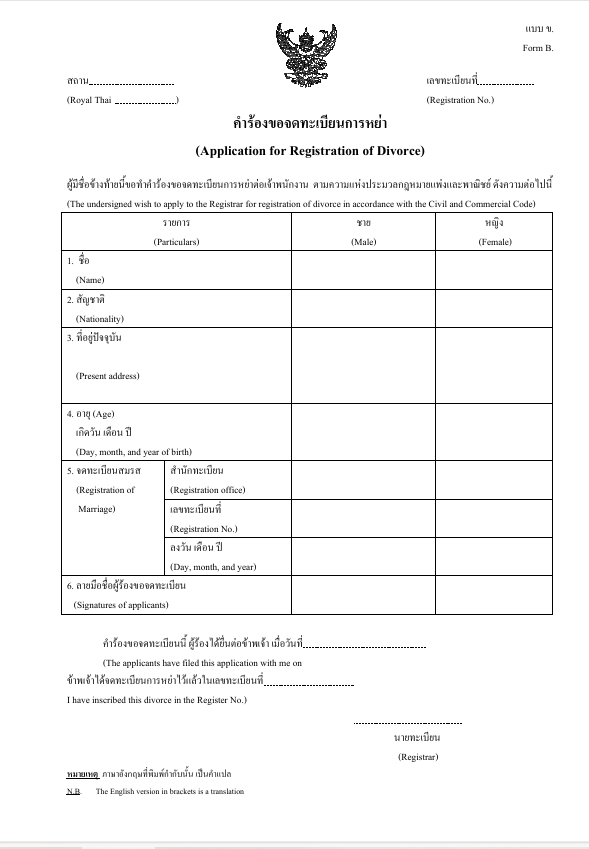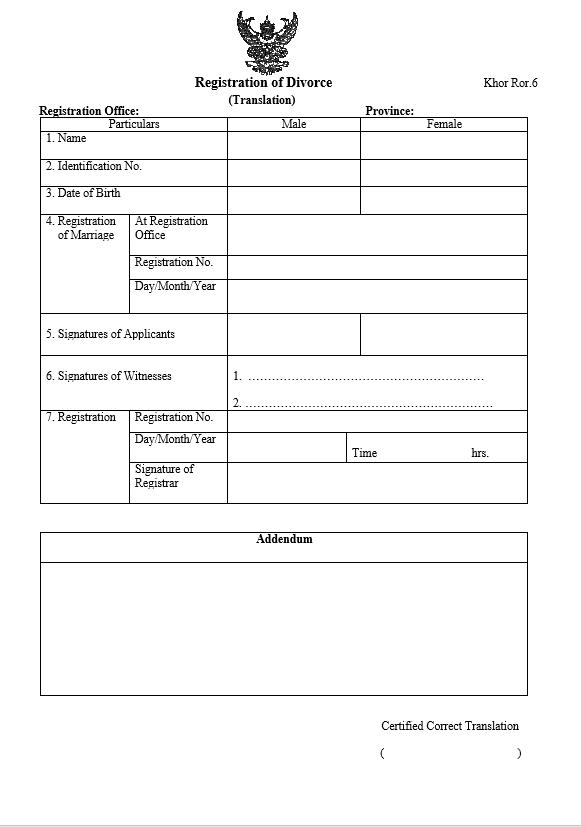Uncontested (Amphur) Divorce in Thailand (Steps, Documents, and How Your Agreement Fits In)
A practical guide for foreigners divorcing a Thai spouse by mutual consent at the district office (amphur/amphoe). Learn what Form B, Kor Ror 6, and Kor Ror 7 are, when to sign them, what to bring, and how to make your DIY Thai–English Divorce Agreement “amphur-ready.”
Page Menu
The 3 Key Papers You’ll Hear About
Form B (แบบ ข.) — Application for Registration of Divorce
The application you both sign at the counter to request a mutual-consent divorce. It captures your particulars and confirms consent so the registrar can proceed.

Kor Ror 6 (คร.6) — Divorce Registration
The official divorce register created after the registrar approves your application and agreement. It records the essential facts and any terms you ask to be recorded. The office keeps the KR6.
Most offices also issue Kor Ror 7 (คร.7) — the Divorce Certificate — for each spouse to take home.

Are Form B and KR6/KR7 Signed the Same Day?
Typically yes. In a standard mutual-consent divorce where both spouses attend the same office, you sign Form B first; the registrar then prepares Kor Ror 6 and Kor Ror 7. You and two witnesses sign as required. You usually take home KR7 the same day, while the office keeps Form B and KR6.
Legal Basis for Mutual-Consent Divorce
Thai law recognizes divorce either by court judgment or by mutual consent. A consent divorce must be in writing and signed by both spouses in the presence of two witnesses — this written document is your Divorce Agreement.
What to Bring (Checklist)
- IDs: Thai ID card / ThaID app for the Thai spouse; passport for the foreign spouse.
- Divorce Agreement: Thai or Thai–English; signed by both spouses and two witnesses. Many offices allow signing on the day using staff as witnesses.
- Marriage papers: Marriage certificate (Kor Ror 3) and, if available, the marriage register extract (Kor Ror 2).
- Children’s documents: Birth certificates if you are recording custody or support terms.
- Prenuptial agreement: If relevant to asset division.
- Small fees: Registration is typically free; certified copies/extracts have minimal fees.
Step-by-Step at the Amphur/Khet (Same-Office Divorce)
- Check in & submit documents. Hand in IDs, marriage papers, and your Divorce Agreement at the start so the officer can review and prepare correct wording for the register.
- Sign Form B (แบบ ข.). This is the application to register the divorce.
- Registrar review. The officer confirms consent, reviews your agreement, and prepares KR6/KR7. Key terms you want on record are typed into the appropriate sections.
- Signatures. Both spouses and two witnesses sign KR6 and KR7.
- Issuance. You receive the Kor Ror 7 certificate; the office retains Form B and Kor Ror 6.
Different-Office Divorce (หย่าต่างสำนักทะเบียน)
Useful if spouses are in different provinces or one is abroad. The process is split between two district offices. The divorce becomes effective when the second office completes registration and issues KR7. In split cases, signatures can occur on different days/locations.
After the Divorce: Using Your Thai Documents Abroad
- Ask the district office if they can issue an English extract (some can).
- Otherwise, obtain certified translations of KR6/KR7, then have them legalized at the MFA Legalization Division.
- Check your home country’s requirements for apostille/legalization via its embassy or consulate.
DIY Divorce Agreement: What to Include
- Property & debts: who keeps what; who pays what; timelines for transfers.
- Children: custody/parental power, residence, visitation, child support (amount, payment method, indexation).
- Spousal maintenance: whether payable and for how long.
- Exact names & IDs: match official records.
- Effective dates: when each clause takes effect.
- Recording clause: authorize the registrar to record key terms in KR6/KR7.
- Witness lines: at least two, as required for consent divorces.
Ready for Registration at the Amphur
Use our lawyer-drafted Thai–English Divorce Agreement (DOCX) to avoid delays at the counter.

